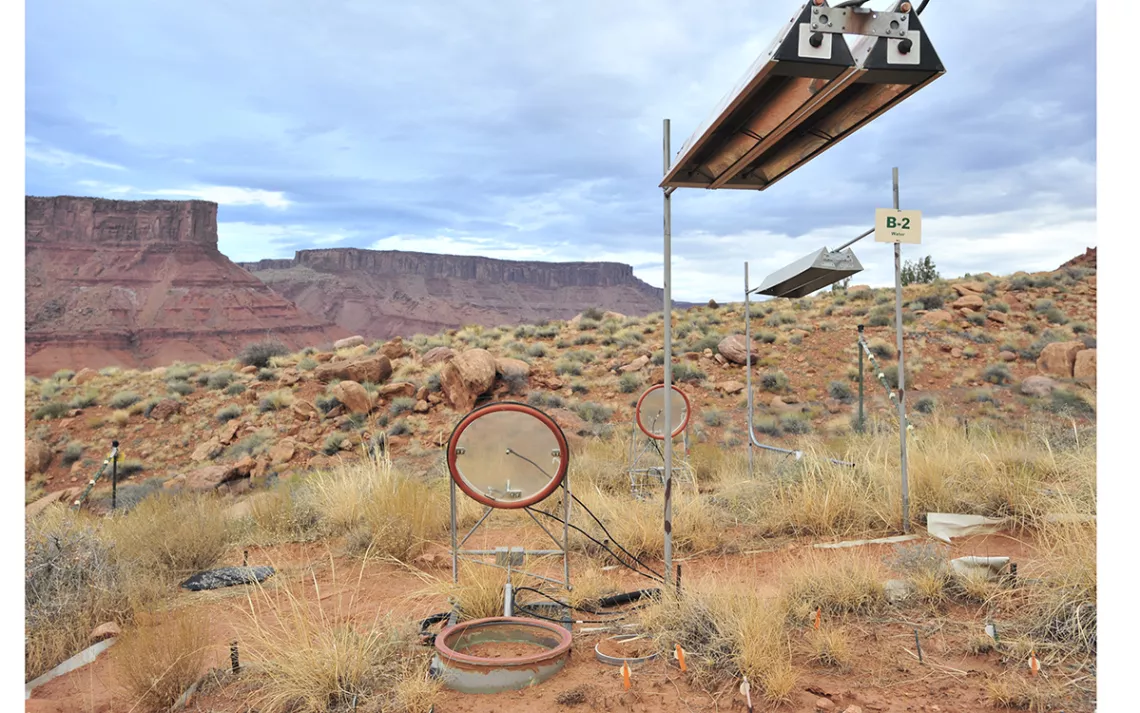You Need This Crust
A guide to properly adoring microbiotic soils

Biocrust research conducted by USGS in Utah in 2016. | Photograph courtesy of Jennifer LaVista
I hadn’t walked very far along the trail in Arches National Park before I started to see the signs. Planted alongside the asphalt of the trail were little posts that read “Your steps matter. Protect park soils.”
Many visitors hadn’t gotten the message. Boot and sneaker prints extended past the boundary, out into the pale red soil. Perhaps the people who had left them didn’t understand that the pleas weren’t just the national park equivalent of “Keep off grass.” When hikers tread off the path, they are trampling on empires—incredible, communal organisms that are vital to the health of the desert.
Desert crust is perfectly adapted to survive extreme temperatures but not foot traffic. | Photograph courtesy of Jennifer LaVista/USGS
Microbiotic soils (also known as biocrust or cryptogamic soil, depending on who you’re talking to) are found in arid places around the world. The term might seem a bit strange, given that all soil contains a panoply of microscopic organisms But what distinguishes microbiotic communities is that they are a collaboration of different entities—fungi, lichen, cyanobacteria, algae, and other tiny organisms that come together in just the top few millimeters of soil.
Despite their unassuming appearance, these dark crusts on the surface of arid soil are actually tiny towers that are critical to the health of the desert. Biocrusts take in carbon and nitrogen and place it back into the soil, where it can be used by surrounding plants. They help keep the desert together—not only preventing dry sediment from blowing away on the wind but trapping sand and dust that’s blown over them. Biocrusts often retain heat too, helping to regulate the rhythm of who’s active when in these arid places. Some organisms found in biocrusts even produce compounds that help to break down pesticides and herbicides, meaning that crusts can help detox the desert such that biodiversity can return to places suffocated by human activity.
“I like to think of biocrusts as full ecosystems that operate at a smaller scale,” says University of Colorado Boulder biologist Anita Antoninka. Each patch of crust is made up of particular organisms that assemble into something more, communities upon communities that challenge our expectations that life is easily divided into discrete units. On a dry, sunny day it’s easy to think of the biocrusts as inert. But when showers douse the desert, Antoninka says, “a major rain can literally make the soil turn green from the activity of mosses, lichens, and cyanobacteria.”
Biocrusts are perfectly adapted to survive the temperature swings and exposure of the desert, Antoninka says, but they have little resistance to compression, which breaks them up. A crust community can repair the damage caused by one step, but repeated trampling by people, cattle, or off-road vehicles (OHVs) damage a community to the point where it can take anywhere from a season to decades to rebuild itself.
Some researchers are studying how to rebuild these communities with the help of lab-grown samples. Antoninka has run several experiments to see how biocrusts can be grown and re-established in damaged areas. In one study, Antoninka and colleagues collected mosses that are found in biocrusts, dried them, added them to Glad containers filled with Moab sand, and attempted to grow the moss in the soil under different conditions. “We’ve gotten pretty good at growing biocrust mosses and cyanobacteria,” she says, “but lichens are difficult.”
Intact biocrusts provide soil stability, capture carbon, and prevent erosion. | Photograph courtesy of Jennifer LaVista/USGS
Success isn’t guaranteed. A restoration experiment carried out in New Mexico’s Bandelier National Monument found no difference between the control and test plots, and other studies have found a similar lack of results. But researchers have had some success with lab-grown biocrust communities taking hold in other sites, such as at test plots in Utah’s Great Basin Desert west of Salt Lake City.
The crusts live and grow at a timescale that’s too small, and sometimes too slow, for us to appreciate. They seem to be part of the setting. And yet our deserts might literally blow away without them, or pesticides might linger that prevent all those other wonderful desert plants—from Datura to fishhook cactus—from taking root.
The next time you pass by such a patch, watch your step and kneel down a moment. Spend a second with these desert denizens. “You can see the action,” Antoninka says, “but perhaps you have to look a little harder to see it.”
Follow in the Writer's Footsteps
Here are a few things you can do to better appreciate the biocrusts that hold our deserts together.
READ UP BEFORE YOU LOOK DOWN The Bureau of Land Management has a handy field guide to biocrusts online, and so does the US Department of Agriculture.
SEE FOR YOURSELF Many of Utah’s desert parks—such as Arches National Park outside Moab and Dinosaur National Monument near Vernal—have biocrust communities you can easily spot.
WATCH YOUR STEP! Soil crusts are delicate. You may have to crouch and practice a little bit of a lean to see them without trampling the biocrusts.
WATCH FOR RAIN After a shower, you might be able to see some of the verdant activity that Antoninka mentions as the mosses and other vegetative life in the biocrusts takes advantage of the moisture.
 The Magazine of The Sierra Club
The Magazine of The Sierra Club



